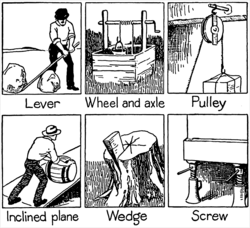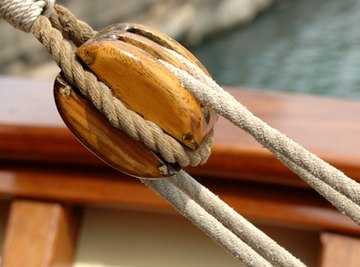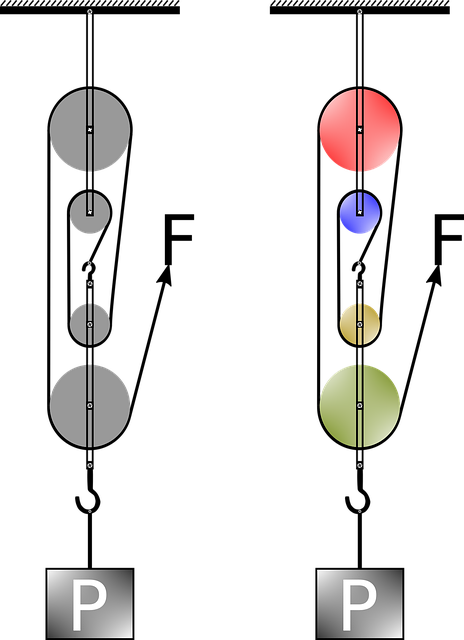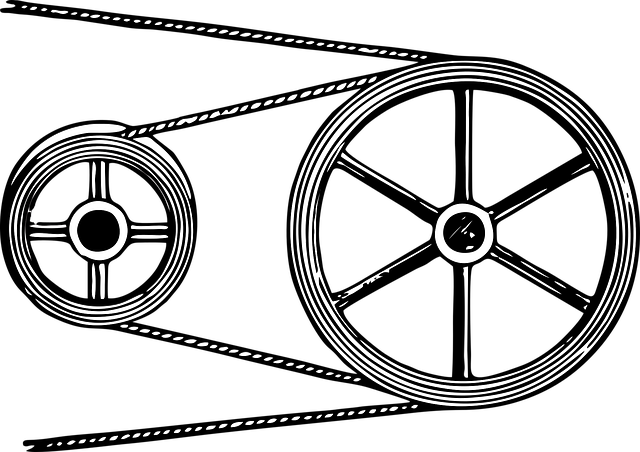Work and Energy Project
A simple machine is a device with few or no moving parts that are used to modify motion and the magnitude of a force in order to perform work.
A simple machine is the simplest mechanisms known that can use mechanical advantage to increase force.
Simple machines help us make better use of our muscle power to do WORK.
A Machine produces FORCE and controls the direction of Force, it cannot create ENERGY.
Simple Machines help us lift, pull, increase elevation of heavy things, change the direction of the force, increase the force, split things, fasten things, and cut things.
Six classical simple machines were defined by Renaissance scientists.
There are six types of simple machine:

- inclined plane
- lever
- wedge
- wheel & axle
- pulley
- screw
We don’t actually know what the first Simple Machine was, but it was probably a large stick (lever) used to move heavy objects (Rocks) or sharp rock used to scrape animal skins (wedge).
Explore some simple machines in the shed here.
We all use simple machines everyday, opening a door, turning on the water faucet, going up stairs, or opening a can of paint.
Simple machines are used to make Work easier by providing a mechanical advantage.
Mechanical Advantage.
Mechanical advantage is a measure of the force amplification achieved by using a tool, mechanical device or machine system.
“Energy is neither created nor destroyed. Although, it may be transformed from one form to another. “
Learning Objectives:
- To understand how simple machines give bigger force at the expense of smaller movement, and smaller force at the expense of bigger movement.
- To understand that work is the product of force and displacement.
- To recognise that energy is neither created nor destroyed, but transformed from one form to another.
Section One – What is Energy?
What is energy?
Energy is the ability to do work.
There are many forms of energy and they can be (broadly) grouped into two general types of energy for doing work:
- Potential, or stored, energy
- Chemical
- Mechanical
- Gravitational
- Nuclear
- Kinetic, or working, energy
- Heat (thermal)
- Light
- Motion
- Electrical
- Sound
Energy is measured in Joules (Newton-meters – Nm).
What is work?
Work is the transfer of energy.
The mount of Work (w) done depends on two things:
A. The amount of Force (F) exerted.
B. The Distance (d) over which the Force is applied.
Equation for Work – w = F x d
Work is measured in Joules (Newton-meters – Nm).
What is Force?
A Force is a PUSH or a PULL.
A force causes a change in the motion or shape of an object.
There are two types of force:
- contact force. For example: applied, friction.
- non-contact force. For Example: gravitational, magnetic.
Force is measured in Newtons – N.
Activity One – Kinetic vs Potential Energy.

Trip to the swings. Take a photo and label the points of energy on the photo.
Section Two – The Law of the Conservation of Energy.
“Energy is neither created nor destroyed. Although, it may be transformed from one form to another. “
This is the Law of The Conservation of Energy, or the first Law of Thermodynamics.
In any system the energy which is used to create work done is not lost, it is transferred.
What is a (physical) system?
A system is a set of parts that form a cohesive (united/connected) whole. The whole system can do things that the individual parts cannot.
Some examples of physical systems are:
- car
- washing machine
- river
- planet
- bridge
There are three types of system:
Isolated System
In an isolated system neither the matter nor the energy can be transferred beyond the system.
- Thermos flask.
- A thermos keeps both heat and matter inside it. Eventually it does cool though so it is not a true isolated system because these do not exist in nature. A more perfect example of an isolated system would be a thermos flask which had been jettisoned into space.
Closed System
In an enclosed (or closed) system the matter can only be transferred within the system, but the energy can leave the system.
- water boiling in a pot with a tight lid.
- The lid attached to the saucepan forbids the flow of matter from the system to the surroundings and vice versa.
Open System
In an open system both matter and energy can be transferred beyond the system.
- water boiling in a pot with no lid.
- Not only does the heat leave the pot but the water also evaporates and eventually the water will disappear.
Perpetual Motion Machines
A perpetual motion machine is a hypothetical machine that can do work indefinitely without an energy source.
The law of conservation of energy states that the total energy of any isolated system remains constant. Remember… energy cannot be created or destroyed,= so if it can’t escape (like the heat from a pot, with or without lid), it must stay inside the system, only that’s not actually possible. Therefore a perpetual motion machine which keeps all its energy for ever cannot be made, although it doesn’t stop people trying.
Mechanical Advantage
Mechanical advantage is a measure of the ratio of output force to input force in a system, used to analyze the forces in simple machines like levers and pulleys.
Mechanical advantage is a measure of the force amplification achieved by using a tool, device, or machine.
The model for this is the law of the lever (see lever section below: “…a force applied to a point farther from the fulcrum must be less than the force located at a point closer in…”).
Activity Two – Pendulum Lab
Interactive Pendulum Demonstration
Create your own pendulum lab with some way of demonstrating and recording the effect of friction on the pendulum and what actions you took to minimize the friction.
Brief Intermission
Reuben Garrett Lucius Goldberg (July 4, 1883 – December 7, 1970) was an American cartoonist, sculptor, author, engineer, and inventor.
He drew cartoons depicting complicated gadgets performing simple tasks in overly complicated ways.
The cartoons led to the expression “Rube Goldberg machines” to describe similar gadgets and processes.
He is the inspiration for international competitions known as Rube Goldberg Machine Contests, which challenge participants to create a complicated machine to perform a simple task.
Section Three – The Inclined Plane
An inclined plane, also known as a ramp, is a flat supporting surface tilted at an angle with one end higher than the other.
It is used as an aid for raising or lowering a load.
Inclined planes are used to move heavy loads over vertical obstacles.
Examples vary from a ramp used to load goods into a truck, to a person walking up a pedestrian ramp, to an automobile or railroad train climbing a grade.
Moving an object up an inclined plane requires less force than lifting it straight up, at a cost of an increase in the distance moved.
Mechanical Advantage
The mechanical advantage of an inclined plane, the factor by which the force is reduced, is equal to the ratio of the length of the sloped surface to the height it spans.
Owing to conservation of energy, the same amount of mechanical energy (work) is required to lift a given object by a given vertical distance, disregarding losses from friction, but the inclined plane allows the same work to be done with a smaller force exerted over a greater distance.
Activity Three – The Inclined Plane
Use a newton spring scale to lift an object straight up, then pull it up various ramps of different heights.
The Newton scale measures the object’s force against gravity (which we think of as weight). What do you observe? Record similar to below.
Object description
Angle of Incline
Object force in Newtons on the slope
Distance (in meters)
Distance x Force (NM)
DxF=Work Done (Joules)
1 cup measure
90 degrees (vertical)
2 N
0.5 M
0.5 x 2
1 J
1 cup measure
20 degrees
1 cup measure
45 degrees
Section Four – The Lever
A lever is a simple machine consisting of a beam or rigid rod pivoted at a fixed hinge, pivot, or fulcrum. A lever is a rigid body capable of rotating on a point on itself.
A lever amplifies an input force to provide a greater output force, which is said to provide leverage, which is mechanical advantage gained by trading off force against movement.
Law of the lever
As the lever rotates around the fulcrum, points farther from the fulcrum move faster than points closer to the fulcrum. Therefore, a force applied to a point farther from the fulcrum must be less than the force located at a point closer in, because power is the product of force and velocity.
Mechanical Advantage
In simple terms it takes less work to move a door handle by holding it at the end than right at the centre, near where it is attached to the door. Use two fingers and try with any levers you find around the house. It is more obvious with longer levers.
Activity Four – The Lever
Use a newton spring scale to lift to balance an object which is a little heavier than it on a balance (lever).
You need to find an object that you can balance with the scale. They probably won’t be the same distance from the fulcrum (balance point).
Here is an example set-up for the balance (lever). You will need either a ruler with centimeter markings or a piece of wood and mark the centimeters on it.

- Use the Newton scale to measure the force (weight) of the object and note it down.
- Balance the object and the scale on the lever and note the object’s distance from the fulcrum and the scale’s distance from the fulcrum.
- Attach the object to the lever.
- Look at the scale while it is balanced with the object. Make a note of the N force of the scale itself.
- Move the scale slightly closer to the fulcrum until the object tips down and see how much force is needed to balance it again.
- Subtract the force of the scale and this is the force exerted.
Do this several times. Each time note the distance of the scale from from the fulcrum (in centimeters).
What do you observe? Record similar to below.
What you should be observing is the torque curve which in simple terms means that to calculate the torque you multiply the distance from the fulcrum with the force applied and the angle of the force (how far you pull the scale down changes the angle).
Create a plot graph if you need to understand this better.
Object description & force (weight in N)
Object distance from fulcrum (keep constant)
Scale distance from fulcrum (to balance both)
Scale Force
Force needed (in N) to balance (minus N of scale on its own)
1/2 cup measure = 1.5N
5cm
14cm
6cm
0.25N
-0.25N
0.75N
Section Five – The Wedge
A wedge is a triangular shaped tool, and is a portable inclined plane.
It can be used to:
- separate two objects or portions of an object
- lift up an object
- hold an object in place
A wedge functions by converting a force applied to its blunt end into forces perpendicular to its inclined surfaces.
The force is applied on a flat, broad surface. This energy is transported to the pointy, sharp end of the wedge, hence the force is transported.
The wedge simply transports energy in the form of friction and collects it to the pointy end, consequently breaking the item.
Mechanical Advantage
The mechanical advantage of a wedge is given by the ratio of the length of its slope to its width. Although a short wedge with a wide angle may do a job faster, it requires more force than a long wedge with a narrow angle.
Activity Five – The Wedge
Find and photograph or draw an example of a wedge and label it to show “The force is applied on a flat, broad surface. This energy is transported to the pointy, sharp end of the wedge, hence the force is transported.”
Section Six – The Wheel & Axle
The wheel and axle is a kind of lever.
It is a type of simple machine. The wheel and axle consists of a round disk, known as a wheel, with a rod through the centre of it, known as the axle. This system uses angular momentum and torque to do work on objects, typically against the force of gravity. The wheel and axle simple machine is closely related to gears.
Like all other simple machines the wheel and axle system changes the force by changing the distance over which the force must be applied; if the input force is reduced to the output force, then the force must be applied over five times the distance. The work done is always force times distance, and this must always be the same because of the conservation of energy.
In simple terms, the larger the wheel, the greater the distance you must turn it, but the easier it is to turn.
Mechanical Advantage
The wheel and axle is used to make tasks easier in terms of manipulating force by applying the concept of mechanical advantage.
In simple terms when using a large wheel less force is needed because the wheel and axle together provide a mechanical advantage. The larger the wheel the greater the advantage.
Activity Six – The Wheel & Axle
The axle will always rotate faster than the wheel to cover the same distance. A smaller wheel will rotate faster than a larger wheel to cover the same distance.
Devise an experiment to demonstrate this.
A suggested experiment:
- Make an axle out of a doweling rod and turn this into a device that winds a string to lift up something (think about an old well and bucket system).
- Trying turning the rod (at the end with just your finger and thumb) to bring up the item.
- Create a wheel and try turning that. Observe the difference in how hard it is to turn vs how much turning is done).
- Create a larger wheel.
- Take some photos.
Calculate the Mechanical Advantage (MA) of using each wheel over just the axle.
- Measure the diameter of the wheel.
- Measure the diameter of the axle
- Divide the diameter of the wheel (Dw) by the diameter of the axle (Da)
- The formula for calculating the MA of a wheel over an axle is Rw/Ra = MA or Dw/Da=MA (R=radius and D =diameter)
- The answer will be in revolutions per second.
Label your photos with this new information.
Section Seven – The Pulley
A pulley is a wheel on an axle or shaft that is designed to support movement and change of direction of a taut cable or belt.
This system is included in the list of simple machines identified by Renaissance scientists.
A block and tackle or only tackle is a system of two or more pulleys with a rope or cable threaded between them, usually used to lift heavy loads.
The rope is threaded through the pulleys to provide mechanical advantage that amplifies the force applied to the rope.
Hero of Alexandria described cranes formed from assemblies of pulleys in the first century.
 Block and tackles are frequently used in areas where heavy machinery is not available and human power must be substituted instead.
Block and tackles are frequently used in areas where heavy machinery is not available and human power must be substituted instead.
In antiquity, block and tackles were used in construction projects to move heavy loads.
In the modern era, they are used frequently on boats where it would be impractical to have a crane or other heavy lifting machinery.
To calculate the mechanical advantage of a simple pulley system is quite easy.

Activity Seven – The Pulley
Create a pulley system and calculate the mechanical advantage. Here is an example:
Section Eight – The Screw
A screw is a mechanism that converts rotational motion to linear motion, and a torque (rotational force) to a linear force.
It is one of the six classical simple machines.
The screw passes through a hole in another object or medium, with threads on the inside of the hole that mesh with the screw’s threads. When the shaft of the screw is rotated relative to the stationary threads, the screw moves along its axis relative to the medium surrounding it; for example rotating a wood screw forces it into wood.
The screw thread is believed to have been invented around 400 BCE, by Archytas of Tarentum, a Greek philosopher sometimes called “the father of mechanics.” The general principle of the screw was applied early on, in cities like Pompeii, to extract olive oil and grape juice.
1. Screw pump
2. Bulb
3. Jar Lid
4. Drill Machine
5. Bolt
6. Bottle Caps
7. Faucets
8. Car Jack
9. Wine Corkscrew
10. Gas Tank Cap
Activity Eight – The Screw
Activity to come – waterscrew.MA or Dw/Da=MA
Work and Energy – Simple Machines
How much have you learned about the concepts of energy, laws of conservation, mechanical advantage, and simple machines?

